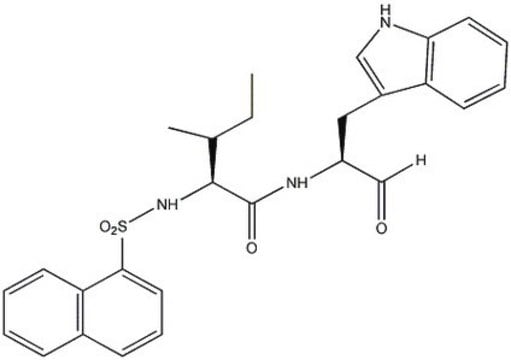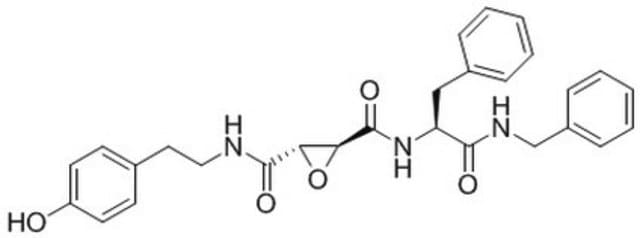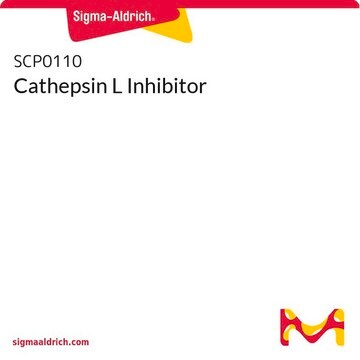219427
Cathepsin L Inhibitor III
The Cathepsin L Inhibitor III controls the biological activity of Cathepsin L. This small molecule/inhibitor is primarily used for Protease Inhibitors applications.
Sinonimo/i:
Cathepsin L Inhibitor III, Z-FY( t-Bu)-DMK, Z-FY(t-Bu)-DMK
Autenticatiper visualizzare i prezzi riservati alla tua organizzazione & contrattuali
About This Item
Formula empirica (notazione di Hill):
C31H34N4O5
Peso molecolare:
542.63
Codice UNSPSC:
12352200
NACRES:
NA.77
Prodotti consigliati
Livello qualitativo
Saggio
≥98% (TLC)
Forma fisica
solid
Produttore/marchio commerciale
Calbiochem®
Condizioni di stoccaggio
OK to freeze
protect from light
Colore
white to light yellow
Solubilità
DMSO: 5 mg/mL
Condizioni di spedizione
ambient
Temperatura di conservazione
−20°C
Descrizione generale
An irreversible inhibitor of Cathepsin L (Cat. No. 219402). About 10,000-fold more effective against cathepsin L than cathepsin S.
An irreversible inhibitor of Cathepsin L (Cat. No. 219402). About 10,000-fold more effective against cathepsin L than cathepsin S.
Azioni biochim/fisiol
Cell permeable: yes
Primary Target
Cathepsin L
Cathepsin L
Product does not compete with ATP.
Reversible: no
Attenzione
Toxicity: Standard Handling (A)
Sequenza
Z-Phe-Tyr(t-Bu)-diazomethylketone
Ricostituzione
Following reconstitution, aliquot and freeze (-20°C). Stock solutions are stable for up to 2 weeks at -20°C.
Altre note
Shaw, E., et al. 1993. FEBS Lett. 334, 340.
Note legali
CALBIOCHEM is a registered trademark of Merck KGaA, Darmstadt, Germany
Codice della classe di stoccaggio
11 - Combustible Solids
Classe di pericolosità dell'acqua (WGK)
WGK 1
Punto d’infiammabilità (°F)
Not applicable
Punto d’infiammabilità (°C)
Not applicable
Certificati d'analisi (COA)
Cerca il Certificati d'analisi (COA) digitando il numero di lotto/batch corrispondente. I numeri di lotto o di batch sono stampati sull'etichetta dei prodotti dopo la parola ‘Lotto’ o ‘Batch’.
Possiedi già questo prodotto?
I documenti relativi ai prodotti acquistati recentemente sono disponibili nell’Archivio dei documenti.
I clienti hanno visto anche
Qi Feng Lin et al.
Journal of virology, 97(10), e0082823-e0082823 (2023-09-25)
Reoviruses infect many mammals and are widely studied as a model system for enteric viruses. However, most of our reovirus knowledge comes from laboratory strains maintained on immortalized L929 cells. Herein, we asked whether naturally circulating reoviruses possess the same
Xiaoxun Li et al.
Theranostics, 11(20), 9821-9832 (2021-11-25)
Background: Bone metastasis is a frequent symptom of breast cancer and current targeted therapy has limited efficacy. Osteoclasts play critical roles to drive osteolysis and metastatic outgrowth of tumor cells in bone. Previously we identified CST6 as a secretory protein
Yongmei Liu et al.
Journal of virology, 97(9), e0060123-e0060123 (2023-09-07)
Canine coronavirus-human pneumonia-2018 (CCoV-HuPn-2018) was recently isolated from a child with pneumonia. This novel human pathogen resulted from cross-species transmission of a canine coronavirus. It has been known that CCoV-HuPn-2018 uses aminopeptidase N (APN) from canines, felines, and porcines, but
Swetha Mohan et al.
Molecular neurodegeneration, 16(1), 51-51 (2021-08-05)
Progranulin loss-of-function mutations are linked to frontotemporal lobar degeneration with TDP-43 positive inclusions (FTLD-TDP-Pgrn). Progranulin (PGRN) is an intracellular and secreted pro-protein that is proteolytically cleaved into individual granulin peptides, which are increasingly thought to contribute to FTLD-TDP-Pgrn disease pathophysiology.
Cong Zeng et al.
bioRxiv : the preprint server for biology (2021-06-09)
Severe acute respiratory syndrome coronavirus 2 (SARS-CoV-2) is a highly transmissible coronavirus responsible for the global COVID-19 pandemic. Herein we provide evidence that SARS-CoV-2 spreads through cell-cell contact in cultures, mediated by the spike glycoprotein. SARS-CoV-2 spike is more efficient
Il team dei nostri ricercatori vanta grande esperienza in tutte le aree della ricerca quali Life Science, scienza dei materiali, sintesi chimica, cromatografia, discipline analitiche, ecc..
Contatta l'Assistenza Tecnica.









